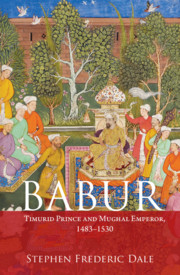Book contents
- Frontmatter
- Dedication
- Contents
- List of Illustrations and Maps
- Preface
- Abbreviations
- Introduction
- 1 Qazaq: A Timurid Vagabond
- 2 Padshahliq, Governance, in Kabul
- 3 Mulkgirliq: The Act of Kingdom-Seizing
- 4 Padshahliq, Governance, in Hindustan
- 5 Gurbatliq: An Indian Exile
- Conclusion
- Glossary
- Bibliography
- Index
- Plate section
1 - Qazaq: A Timurid Vagabond
Published online by Cambridge University Press: 13 September 2018
- Frontmatter
- Dedication
- Contents
- List of Illustrations and Maps
- Preface
- Abbreviations
- Introduction
- 1 Qazaq: A Timurid Vagabond
- 2 Padshahliq, Governance, in Kabul
- 3 Mulkgirliq: The Act of Kingdom-Seizing
- 4 Padshahliq, Governance, in Hindustan
- 5 Gurbatliq: An Indian Exile
- Conclusion
- Glossary
- Bibliography
- Index
- Plate section
Summary
In 1488, the 5-year-old Zahir al-Din Muhammad Babur – the future founder of the Timurid-Mughal Empire of India – travelled more than 300 miles from his home in the Ferghanah Valley westward to the ancient Central Asian city of Samarqand, which was formerly the capital of the Turco-Mongol conqueror Temür (1336–1405). Babur, the eldest son of ‘Umar Shaikh Mirza (d. 1494), a fourth-generation descendant of Temür, very likely left on his journey from his father's base at Akhsı. It was a Ferghanah town and citadel located high on the north bank of the Syr Darya River. He was probably escorted on his trip by his mother Qutluq Nigar Khanım (d. 1505) – the second daughter of Yunas Khan (d. 1487), the recently deceased Khan of the Chaghatai Mongols and a direct descendant of Chinggis Khan (1162–1227). Babur was taken to Samarqand to be betrothed to his equally young first cousin ‘Ayisha Sultan Begim – the daughter of his paternal uncle Ahmad Mirza (d. 1494), the ruler of Samarqand. He consummated the marriage eleven years later in 1500, noting the event with a single laconic sentence in his autobiography. ‘Sultan Ahmad Mirza's daughter, named ‘Ayisha Sultan Begim, whom my father and hers affianced to me, came to Khujand and I married her in the month of Sha‘ban.’
By his descent from both Temür and Chinggis Khan, Babur inherited an impeccable Central Asian, Turco-Mongol legitimacy. Since he was a patrilineal descendant of Temür, Babur was a Timurid, and the dynastic identity doubled by the marriage to his young cousin. He and his male relations derived their imperial ambitions from Temür, an Islamised member of the Barlas tribe – a Turkicised Mongol tribe – whose homeland was located near Kish, 48 miles south of Samarqand. While not a descendant of Chinggis Khan, Temür married into the Chinggisid line taking the title Gurkan or son-in-law, and he assumed the title Temür Gurkan. Gurkanian became the official dynastic name of the Timurids of Central Asia as well as their Indian descendants. Babur does not, however, use this term to refer to his own political lineage. He once alludes to himself as one of the Timuriyeh Salatını, ‘Timurid Sultans’, but more commonly, he refers to Temür's descendants, including himself, simply as Turks.
- Type
- Chapter
- Information
- BaburTimurid Prince and Mughal Emperor, 1483-1530, pp. 23 - 58Publisher: Cambridge University PressPrint publication year: 2018



